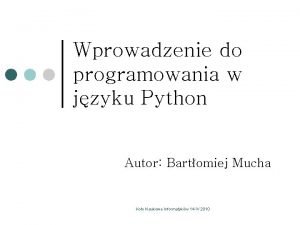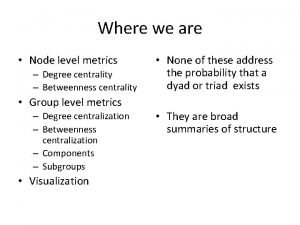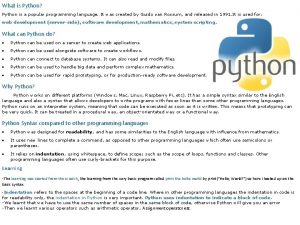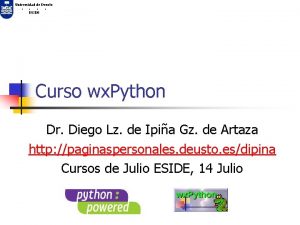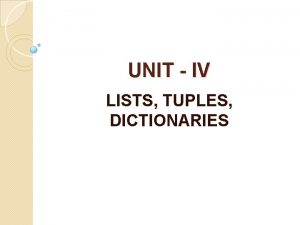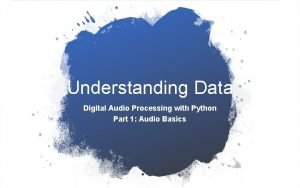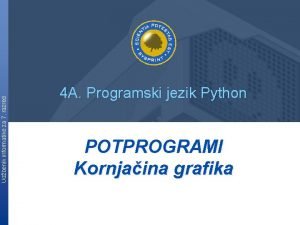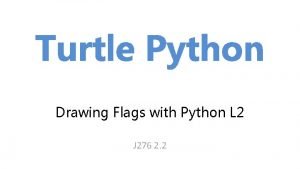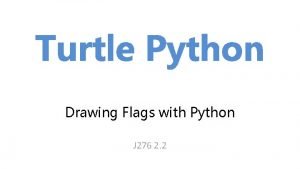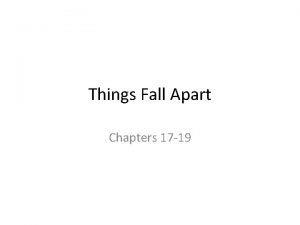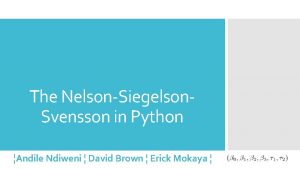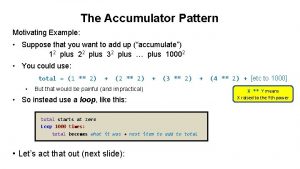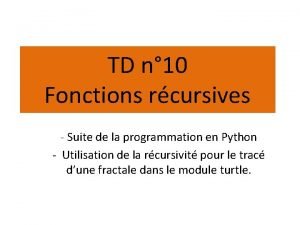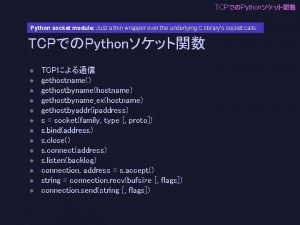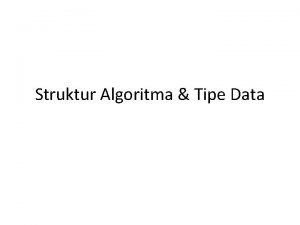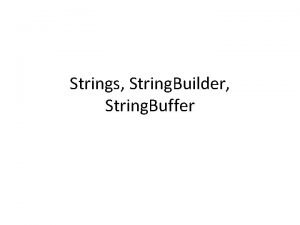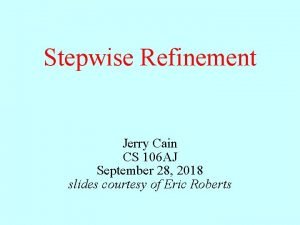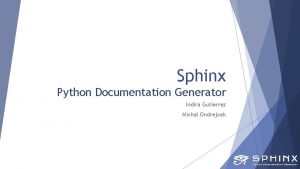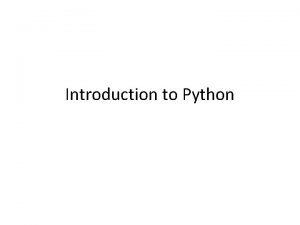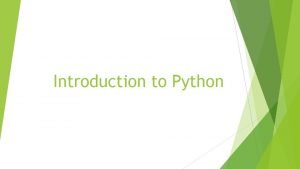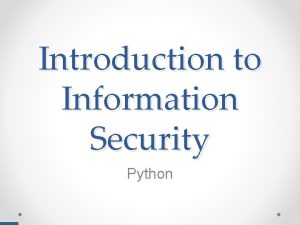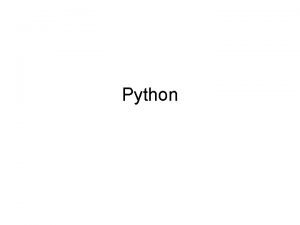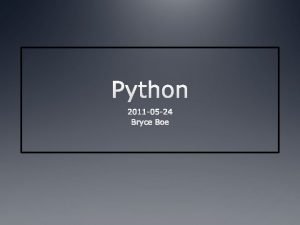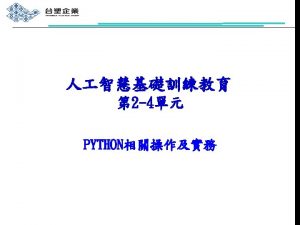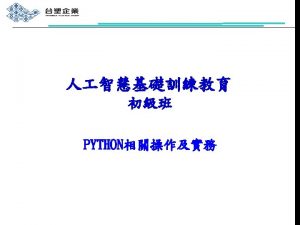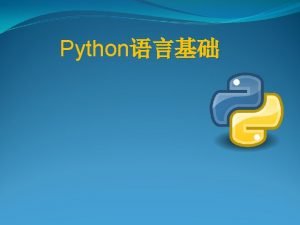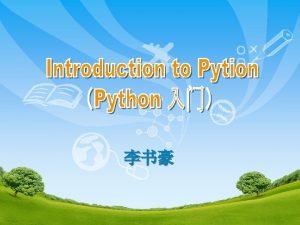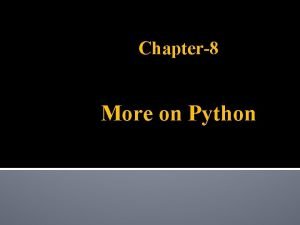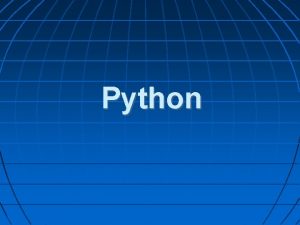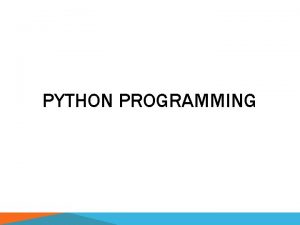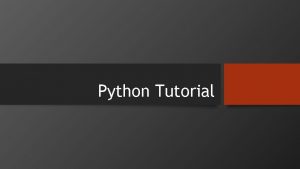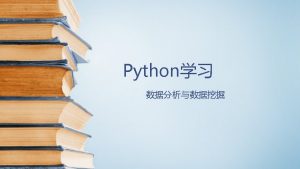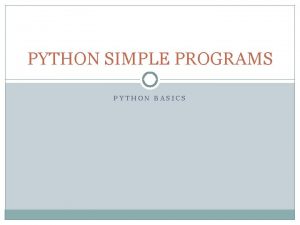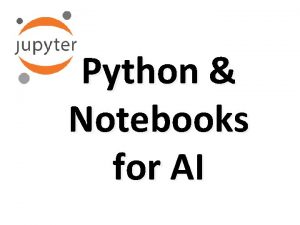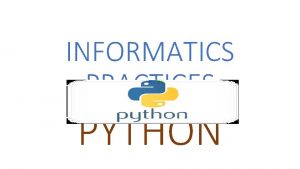Introduction to Python Introduction to Python Python is










![Other Python Objects • Lists (mutable sets of strings) – var = [] # Other Python Objects • Lists (mutable sets of strings) – var = [] #](https://slidetodoc.com/presentation_image/2070c5ccb6b24e4363627687a28f792e/image-11.jpg)

![List Methods • Adding to the List – var[n] = object • replaces n List Methods • Adding to the List – var[n] = object • replaces n](https://slidetodoc.com/presentation_image/2070c5ccb6b24e4363627687a28f792e/image-13.jpg)












- Slides: 25

Introduction to Python

Introduction to Python • Python is a high-level programming language • Open source and community driven • “Batteries Included” – a standard distribution includes many modules • Dynamic typed • Source can be compiled or run just-in-time • Similar to perl, tcl, ruby

Why Python? • Unlike AML and Avenue, there is a considerable base of developers already using the language • “Tried and true” language that has been in development since 1991 • Can interface with the Component Object Model (COM) used by Windows • Can interface with Open Source GIS toolsets

Why not Visual Basic? • Visual Basic is still the method of configuring and customizing Arc. Map • If you have a button on the toolbar, it’s VB • Python scripts can be placed in Arc. Toolbox • Python can be run from the command line without Arc. Map or Arc. Catalog being open • Using just the GIS Engine, lower overhead • Rapid prototyping, ease of authoring, etc.

Python Interfaces • IDLE – a cross-platform Python development environment • Python. Win – a Windows only interface to Python • Python Shell – running 'python' from the Command Line opens this interactive shell • For the exercises, we'll use IDLE, but you can try them all and pick a favorite

IDLE – Development Environment • IDLE helps you program in Python by: – color-coding your program code – debugging – auto-indent – interactive shell

Example Python • Hello World print “hello world” • Prints hello world to standard out • Open IDLE and try it out yourself • Follow along using IDLE

More than just printing • Python is an object oriented language • Practically everything can be treated as an object • “hello world” is a string • Strings, as objects, have methods that return the result of a function on the string

String Methods • Assign a string to a variable • In this case “hw” • hw. title() • hw. upper() • hw. isdigit() • hw. islower()

String Methods • The string held in your variable remains the same • The method returns an altered string • Changing the variable requires reassignment – hw = hw. upper() – hw now equals “HELLO WORLD”
![Other Python Objects Lists mutable sets of strings var Other Python Objects • Lists (mutable sets of strings) – var = [] #](https://slidetodoc.com/presentation_image/2070c5ccb6b24e4363627687a28f792e/image-11.jpg)
Other Python Objects • Lists (mutable sets of strings) – var = [] # create list – var = [‘one’, 2, ‘three’, ‘banana’] • Tuples (immutable sets) – var = (‘one’, 2, ‘three’, ‘banana’) • Dictionaries (associative arrays or ‘hashes’) – var = {} # create dictionary – var = {‘lat’: 40. 20547, ‘lon’: -74. 76322} – var[‘lat’] = 40. 2054 • Each has its own set of methods

Lists • Think of a list as a stack of cards, on which your information is written • The information stays in the order you place it in until you modify that order • Methods return a string or subset of the list or modify the list to add or remove components • Written as var[index], index refers to order within set (think card number, starting at 0) • You can step through lists as part of a loop
![List Methods Adding to the List varn object replaces n List Methods • Adding to the List – var[n] = object • replaces n](https://slidetodoc.com/presentation_image/2070c5ccb6b24e4363627687a28f792e/image-13.jpg)
List Methods • Adding to the List – var[n] = object • replaces n with object – var. append(object) • adds object to the end of the list • Removing from the List – var[n] = [] • empties contents of card, but preserves order – var. remove(n) • removes card at n – var. pop(n) • removes n and returns its value

Lists in Arc. Toolbox You will create lists: • Layers as inputs • Attributes to match • Arrays of objects You will work with lists: • List of field names • List of selected features

Tuples • Like a list, tuples are iterable arrays of objects • Tuples are immutable – once created, unchangeable • To add or remove items, you must redeclare • Example uses of tuples – County Names – Land Use Codes – Ordered set of functions

Dictionaries • Dictionaries are sets of key & value pairs • Allows you to identify values by a descriptive name instead of order in a list • Keys are unordered unless explicitly sorted • Keys are unique: – var[‘item’] = “apple” – var[‘item’] = “banana” – print var[‘item’] prints just banana

Indentation and Blocks • Python uses whitespace and indents to denote blocks of code • Lines of code that begin a block end in a colon: • Lines within the code block are indented at the same level • To end a code block, remove the indentation • You'll want blocks of code that run only when certain conditions are met

Conditional Branching • if and else if variable == condition: #do something based on v == c else: #do something based on v != c • elif allows for additional branching if condition: elif another condition: … else: #none of the above

Looping with For • For allows you to loop over a block of code a set number of times • For is great for manipulating lists: a = ['cat', 'window', 'defenestrate'] for x in a: print x, len(x) Results: cat 3 window 6 defenestrate 12

Looping with For • We could use a for loop to perform geoprocessing tasks on each layer in a list • We could get a list of features in a feature class and loop over each, checking attributes • Anything in a sequence or list can be used in a For loop • Just be sure not to modify the list while looping

Modules • Modules are additional pieces of code that further extend Python’s functionality • A module typically has a specific function – additional math functions, databases, network… • Python comes with many useful modules • arcgisscripting is the module we will use to load Arc. GIS toolbox functions into Python

Modules • Modules are accessed using import – import sys, os # imports two modules • Modules can have subsets of functions – os. path is a subset within os • Modules are then addressed by modulename. function() – sys. argv # list of arguments – filename = os. path. splitext("points. txt") – filename[1] # equals ". txt"

Files • Files are manipulated by creating a file object – f = open("points. txt", "r") • The file object then has new methods – print f. readline() # prints line from file • Files can be accessed to read or write – f = open("output. txt", "w") – f. write("Important Output!") • Files are iterable objects, like lists

Error Capture • Check for type assignment errors, items not in a list, etc. • Try & Except try: a block of code that might have an error except: code to execute if an error occurs in "try" • Allows for graceful failure – important in Arc. GIS

Additional Python Resources • Python Homepage http: //www. python. org/ • Dive Into Python http: //www. diveintopython. org/ • Learning Python, 3 rd Edition http: //www. oreilly. com/catalog/9780596513986/ • Getting Started Writing Geoprocessing Scripts Available on ESRI's support page
 Python programming an introduction to computer science
Python programming an introduction to computer science Introduction paragraph format
Introduction paragraph format Nww python
Nww python Ergm python
Ergm python How was python created
How was python created Violent python 3
Violent python 3 Arabic wordnet python
Arabic wordnet python Hitran python
Hitran python Eside deusto
Eside deusto String list tuple dictionary in python
String list tuple dictionary in python Scipy audio processing
Scipy audio processing Informatika 7 razred python
Informatika 7 razred python Duck typing
Duck typing Flag in python
Flag in python Python flag
Python flag Comentar no python
Comentar no python Things fall apart chapter 19 summary
Things fall apart chapter 19 summary Nelson siegel svensson model excel
Nelson siegel svensson model excel Accumulator pattern
Accumulator pattern Python factoriel
Python factoriel Gethostbyname_ex
Gethostbyname_ex Contoh stack python
Contoh stack python Tipe flowchart
Tipe flowchart Buffer vs builder
Buffer vs builder Stepwise refinement python
Stepwise refinement python Python documentation generator sphinx
Python documentation generator sphinx


